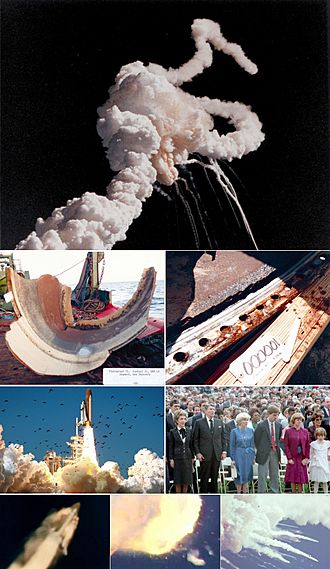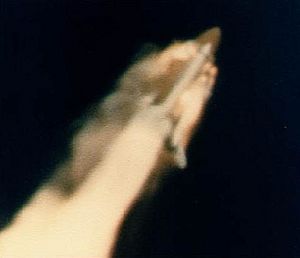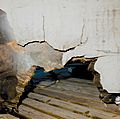Space Shuttle Challenger disaster facts for kids

Photo montage of the Space Shuttle Challenger disaster
|
|
| Date | January 28, 1986 |
|---|---|
| Time | 11:39:13 EST (16:39:13 UTC) |
| Location | Atlantic Ocean, off the coast of Florida |
| Outcome | Grounding of the Space Shuttle fleet for nearly three years during which various safety measures, solid rocket booster redesign, and a new policy on management decision-making for future launches were implemented. |
| Deaths |
|
| Inquiries | Rogers Commission |
The Space Shuttle Challenger disaster happened on January 28, 1986. The NASA space shuttle, named Space Shuttle Challenger Challenger, broke apart just 73 seconds after it launched. All seven people on board died. This was the 25th flight for a Space Shuttle.
The main reason for the accident was a small part called an O-ring. This O-ring was in the right solid rocket booster, which helps push the shuttle into space. The O-ring broke, allowing hot gases to escape. This caused the shuttle to break apart in the sky. After this sad event, space shuttles stopped flying for about two and a half years.
Contents
What Happened Before Launch?
It was very cold on the morning the Challenger was supposed to launch. Engineers, who are like expert builders and designers, were worried. They said the shuttle should not take off because the temperature was 31 °F (−1 °C; 273 K). They knew that the O-rings might not work correctly if it was colder than 53 °F (12 °C; 285 K).
However, the NASA leaders decided to go ahead with the launch. They thought a backup O-ring would keep everyone safe. Sadly, they were wrong. It was so cold that icicles were hanging from parts of the launch pad.
How the Shuttle Broke Apart
About a minute after the Challenger lifted off, its engines powered up to full thrust. The flight controllers on the ground told the crew that everything looked good. The shuttle commander, Dick Scobee, replied, "Roger, go at throttle up."
But just 72 seconds after launch, the right booster pulled away from the main fuel tank. The Challenger suddenly went off its planned path. The crew might have felt this sudden change. Half a second later, the pilot, Michael Smith, said the last words recorded from the crew cabin: "Uh oh..." He might have been reacting to the shuttle's computer trying to fix the problem.
What Happened to the Crew?
Not much is known about what happened right after the shuttle broke apart. The part where the crew sat, called the crew cabin, stayed together for a while as it fell. An official report about the disaster said that the crew likely survived the first breakup. At least three crew members were still alive. They even moved some switches, which needed a cover to be pulled off first. This suggests they might have tried to regain control of the falling craft.
The crew cabin did not have parachutes. It crashed into the ocean after falling for 2 minutes and 45 seconds. It was moving very fast, at about 207 miles per hour (333 kilometres per hour). Any crew members who survived the initial breakup died instantly when the cabin hit the water. The force was like going from 0 to over 4,400 miles per hour (7,100 kilometres per hour) and then stopping in just one second.
The Investigation
Many people wanted to know why the Challenger exploded. The President, Ronald Reagan, asked for a special report. This report was called the Rogers Commission Report. A group of astronauts, scientists, and engineers wrote it. They worked hard to figure out exactly what happened and why.
The report found that NASA leaders did not listen to the engineers. The engineers had warned them that the O-rings were not safe in cold weather. The report also said that sometimes leaders at NASA thought parts of the shuttle were safer than they really were. It also mentioned that NASA sometimes took risks because people would get upset if shuttle launches were delayed.
No space shuttles flew while the report was being written. After the report was finished, NASA had to make many changes to be much more careful with safety.
Related pages
Images for kids
-
Gray smoke escaping from the right-side solid rocket booster
-
Members of the Rogers Commission arrive at Kennedy Space Center
See also
 In Spanish: Accidente del transbordador espacial Challenger para niños
In Spanish: Accidente del transbordador espacial Challenger para niños













